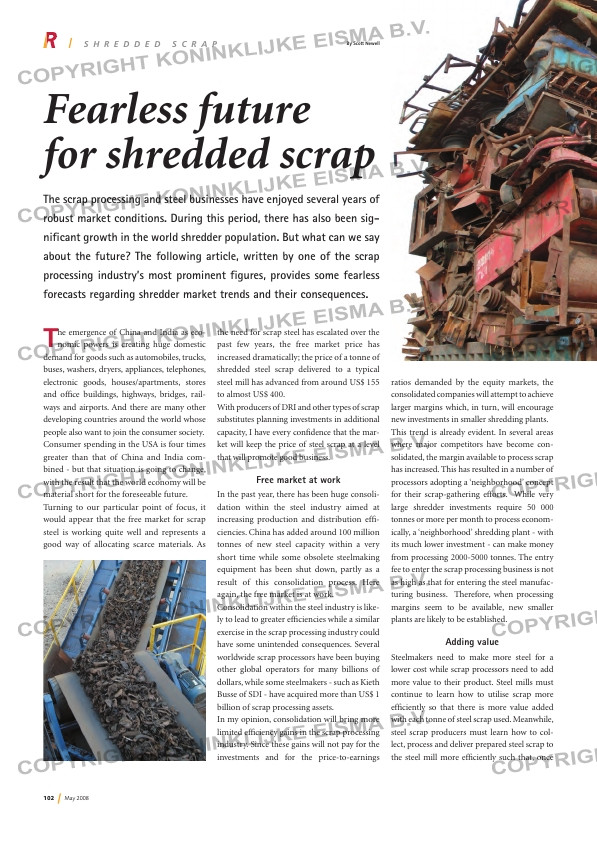Page 102 from: May 2008

102 May 2008
S h r e d d e d S c r a p
The emergence of China and India as eco-nomic powers is creating huge domestic
demand for goods such as automobiles, trucks,
buses, washers, dryers, appliances, telephones,
electronic goods, houses/apartments, stores
and offi ce buildings, highways, bridges, rail-
ways and airports. And there are many other
developing countries around the world whose
people also want to join the consumer society.
Consumer spending in the USA is four times
greater than that of China and India com-
bined – but that situation is going to change,
with the result that the world economy will be
material short for the foreseeable future.
Turning to our particular point of focus, it
would appear that the free market for scrap
steel is working quite well and represents a
good way of allocating scarce materials. As
the need for scrap steel has escalated over the
past few years, the free market price has
increased dramatically; the price of a tonne of
shredded steel scrap delivered to a typical
steel mill has advanced from around US$ 155
to almost US$ 400.
With producers of DRI and other types of scrap
substitutes planning investments in additional
capacity, I have every confi dence that the mar-
ket will keep the price of steel scrap at a level
that will promote good business.
Free market at work
In the past year, there has been huge consoli-
dation within the steel industry aimed at
increasing production and distribution effi –
ciencies. China has added around 100 million
tonnes of new steel capacity within a very
short time while some obsolete steelmaking
equipment has been shut down, partly as a
result of this consolidation process. Here
again, the free market is at work.
Consolidation within the steel industry is like-
ly to lead to greater effi ciencies while a similar
exercise in the scrap processing industry could
have some unintended consequences. Several
worldwide scrap processors have been buying
other global operators for many billions of
dollars, while some steelmakers – such as Kieth
Busse of SDI – have acquired more than US$ 1
billion of scrap processing assets.
In my opinion, consolidation will bring more
limited effi ciency gains in the scrap processing
industry. Since these gains will not pay for the
investments and for the price-to-earnings
ratios demanded by the equity markets, the
consolidated companies will attempt to achieve
larger margins which, in turn, will encourage
new investments in smaller shredding plants.
This trend is already evident. In several areas
where major competitors have become con-
solidated, the margin available to process scrap
has increased. This has resulted in a number of
processors adopting a ‘neighborhood’ concept
for their scrap-gathering efforts. While very
large shredder investments require 50 000
tonnes or more per month to process econom-
ically, a ‘neighborhood’ shredding plant – with
its much lower investment – can make money
from processing 2000-5000 tonnes. The entry
fee to enter the scrap processing business is not
as high as that for entering the steel manufac-
turing business. Therefore, when processing
margins seem to be available, new smaller
plants are likely to be established.
Adding value
Steelmakers need to make more steel for a
lower cost while scrap processors need to add
more value to their product. Steel mills must
continue to learn how to utilise scrap more
effi ciently so that there is more value added
with each tonne of steel scrap used. Meanwhile,
steel scrap producers must learn how to col-
lect, process and deliver prepared steel scrap to
the steel mill more effi ciently such that, once
The scrap processing and steel businesses have enjoyed several years of
robust market conditions. During this period, there has also been sig-
nificant growth in the world shredder population. But what can we say
about the future? The following article, written by one of the scrap
processing industry’s most prominent figures, provides some fearless
forecasts regarding shredder market trends and their consequences.
Fearless future
for shredded scrap
By Scott Newell
RI_061_Shredded Scrap.indd 2 14-05-2008 14:04:37



